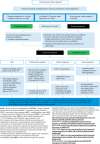Diagnosis and treatment of chronic bacterial prostatitis and chronic prostatitis/chronic pelvic pain syndrome: a consensus guideline
- PMID: 25711488
- PMCID: PMC5008168
- DOI: 10.1111/bju.13101
Diagnosis and treatment of chronic bacterial prostatitis and chronic prostatitis/chronic pelvic pain syndrome: a consensus guideline
Abstract
Objectives: To improve awareness and recognition of chronic bacterial prostatitis (CBP) and chronic prostatitis/chronic pelvic pain syndrome (CP/CPPS) among non-specialists and patients. To provide guidance to healthcare professionals treating patients with CBP and CP/CPPS, in both non-specialist and specialist settings. To promote efficient referral of care between non-specialists and specialists and the involvement of the multidisciplinary team (MDT).
Patients and methods: The guideline population were men with CBP or CP/CPPS (persistent or recurrent symptoms and no other urogenital pathology for ≥3 of the previous 6 months). Consensus recommendations for the guidelines were based on a search to identify literature on the diagnosis and management of CBP and CP/CPPS (published between 1999 and February 2014). A Delphi panel process was used where high-quality, published evidence was lacking.
Results: CBP and CP/CPPS can present with a wide range of clinical manifestations. The four main symptom domains are urogenital pain, lower urinary tract symptoms (LUTS - voiding or storage symptoms), psychological issues and sexual dysfunction. Patients should be managed according to their individual symptom pattern. Options for first-line treatment include antibiotics, α-adrenergic antagonists (if voiding LUTS are present) and simple analgesics. Repeated use of antibiotics, such as quinolones, should be avoided if there is no obvious symptomatic benefit from infection control or cultures do not support an infectious cause. Early use of treatments targeting neuropathic pain and/or referral to specialist services should be considered for patients who do not respond to initial measures. An MDT approach (urologists, pain specialists, nurse specialists, specialist physiotherapists, general practitioners, cognitive behavioural therapists/psychologists, and sexual health specialists) is recommended. Patients should be fully informed about the possible underlying causes and treatment options, including an explanation of the chronic pain cycle.
Conclusion: Chronic prostatitis can present with a wide variety of signs and symptoms. Identification of individual symptom patterns and a symptom-based treatment approach are recommended. Further research is required to evaluate management options for CBP and CP/CPPS.
Keywords: chronic bacterial prostatitis; chronic prostatitis with chronic pelvic pain syndrome; guidelines; prostatitis.
© 2015 The Authors BJU International published by John Wiley & Sons Ltd on behalf of BJU International.
Figures

Comment in
-
Chronic prostatitis: how to give our best without apposite vagueness.BJU Int. 2015 Oct;116(4):499-500. doi: 10.1111/bju.13150. BJU Int. 2015. PMID: 26350575 No abstract available.
References
-
- Pavone‐Macaluso M. Chronic prostatitis syndrome: a common, but poorly understood condition. Part I. EAU‐EBU Update Ser 2007; 5: 1–15
-
- Nyberg LM, Krieger JN, Nickel JC. National Institutes of Health Classification of Chronic Prostatitis In Nickel JC. ed, Textbook of Prostatitis. London: CRC Press, 1999: 28
-
- University of Oxford Centre for Evidence Based Medicine . OCEBM Levels of Evidence System. Available at: http://www.cebm.net/index.aspx?o=5653. Accessed June 2014
Publication types
MeSH terms
LinkOut - more resources
Full Text Sources
Other Literature Sources
Medical
Miscellaneous

